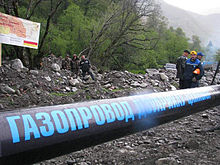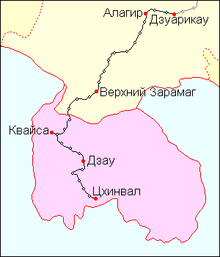|
Dzuarikau–Tskhinvali pipeline
The Dzuarikau–Tskhinvali pipeline (Ossetian: Газуадзæн «Дзуарыхъæу—Цхинвал») is a natural gas pipeline running from the village of Dzuarikau in North Ossetia to Tskhinvali, South Ossetia. Construction started in 2006, and gas supplies started in September 2009.[citation needed] HistoryConstruction of the pipeline was planned for a long time and it started in December 2006.[1] It was launched on 26 August 2009.[citation needed] Previously, South Ossetia was supplied from the Agara-Tskhinvali leg of the Tbilisi-Kutaisi trunk system of Georgia.[citation needed] After the Georgian-Ossetian conflict, supplies to South Ossetia from Georgia were cut off. According to Georgia, the cause was a damaged section of the pipeline within South Ossetia, while Russia denied the damage and accused Georgia of the deliberate cutoff. Supplies were restored in January 2009.[citation needed] Technical descriptionThe length of the pipeline is 162.3 kilometres (100.8 mi) and it has capacity of 252.5 million cubic meters of natural gas per year.[2][3] The diameter of the pipeline is 426 millimetres (16.8 in). Around 70.2 kilometres (43.6 mi) of the pipeline is in South Ossetian territory.[citation needed] The pipeline passes through mountainous regions with a maximum altitude of 3,148 metres (10,328 ft) above sea level. It has been reported that the pipeline may be the located the highest in the world.[2] The cost of construction was 15 billion rubles (US$476 million).[citation needed] The pipeline is operated by Gazprom Transgaz Stavropol, a subsidiary of Gazprom. It was built by Stroyprogress. Political significanceThe pipeline was said to be important for the de facto independence of South Ossetia, because it "shakes off the last levers exerted by its unfriendly neighbour".[2] The Georgian foreign ministry protested against the launch of the pipeline.[4] See alsoReferences
|
||||||||||||||||||||||||||||||


